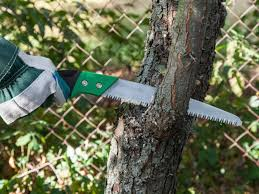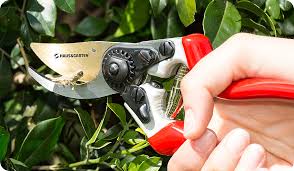Pruning is an essential task for maintaining healthy fruit trees and bushes. It’s best done in three stages: first, removing large branches that affect the plant’s shape, then tackling medium-sized branches or canes, and finishing with a final clean-up of smaller twigs that could cause problems later. Having the right tools for each stage makes a big difference. Over time, I’ve found three pruning tools that every fruit gardener should have.
1. Pruning Saws for Larger Branches
When you need to make significant changes to your plant, a pruning saw is the tool to use. Pruning saws are great for cutting through larger branches, making them an essential part of your tool kit. A bow saw is particularly effective for cutting thick tree limbs, though it can be tricky in tight spaces. For more confined areas, a folding saw offers convenience, though it may not be as sturdy as a fixed-blade saw.
For a good all-around tool, choose a pruning saw with a blade less than 18 inches (45 cm) long. A comfortable handle ensures you can maneuver the saw easily, especially when space is limited. If you’re tackling hard-to-reach branches, a Grecian saw is a fantastic option. Its curved blade allows you to cut effectively in confined spaces by only cutting on the pull stroke, where you can apply the most pressure.
For larger projects, such as renovating an entire orchard or preparing firewood, you might want to consider a chainsaw. Whether electric, petrol-powered, or rechargeable battery models, chainsaws are powerful and efficient for big jobs.د

2. Loppers for Medium-Sized Branches
Once the thick branches are dealt with, loppers come in handy for pruning smaller branches and soft fruit canes up to about 1 inch (2.5 cm) thick. When selecting loppers, look for models with telescoping handles, which provide extra reach for higher branches without the need for a ladder. This also increases leverage, making it easier to cut through branches with less effort.
Loppers with a ratchet mechanism reduce the force needed, making them easier to use for extended periods. Make sure to test the weight of the loppers before buying. Extend them fully and try opening and closing them to ensure they aren’t too heavy or difficult to manage.
There are two main types of lopper blades: anvil and bypass. Anvil loppers have a flat anvil for the cutting blade to work against, which is great for clean cuts, but they require frequent sharpening. Bypass loppers, with scissor-action blades, are often gentler on the branches but may need more precise handling.
3. Hand Pruners for Fine Work
Hand pruners, or secateurs, are the go-to tool for trimming small twigs and soft fruit canes up to about 0.5 inches (1 cm) thick. A good pair of pruners is a worthwhile investment since you’ll use them frequently for quick cuts. Bypass pruners are ideal for making clean cuts on thin stems. However, avoid using them on thicker wood, as this can damage the blades.

When purchasing pruners, ensure the grips fit comfortably in your hand, and that the spring pressure isn’t too high, or you’ll tire quickly during use. Also, check the safety catch to ensure it securely locks and won’t disengage accidentally. Hand pruners are handy for on-the-go pruning jobs, like cutting away damaged or diseased twigs, and a pruner holster can keep them easily accessible while you’re working.
Conclusion
With the right tools—pruning saws, loppers, and hand pruners—you’ll be equipped to handle any pruning job in your fruit garden. Take care to choose high-quality tools that suit your needs and make regular maintenance easier and more efficient. What other pruning tools do you swear by? Let us know in the comments below!
